
Why Luzon Should Be Your First Stop in the Philippines
Welcome to Luzon—the island that has it all. History buffs, foodies, surfers, hikers, and sunset-chasers will all find their fix here. This Luzon travel guide is packed with the top things to do in Luzon, from exploring ancient rice terraces to sipping cocktails in luxury resorts in Luzon.
If you’re wondering about the best Luzon tourist spots, think of it as a sampler platter: Intramuros in Manila, the Banaue Rice Terraces, Pagudpud’s beaches, and Manila Bay’s world-famous sunset. And yes, you’ll need stretchy pants—the Luzon food guide section will prove why.
What To Expect in This Article
Why Luzon? Let me break it down like a karaoke machine at 2 AM:
- One Island, Every Vibe.
Want beaches? Done. Want mountains? Double done. Want cobblestone streets that look like Spain but smell like garlic longganisa? Welcome to Vigan. - History + Modern Chaos.
Intramuros takes you back to the Spanish era, while BGC makes you feel like you’re in Singapore—just with cheaper beer and livelier karaoke. - Food to Ruin Your Diet.
Luzon gives you isaw (grilled chicken intestines that taste better than they sound), Bicol Express (a dish so spicy it’ll test your survival skills), and strawberries fresh from Baguio. Oh, and let’s not forget the halo-halo—a dessert that looks like a unicorn exploded in a bowl, but trust me, it’s heaven. - Tourist Spots Galore.
Banaue Rice Terraces (a.k.a. Nature’s Stairmaster), Mt. Pinatubo’s crater lake, Sagada’s hanging coffins, La Union’s surf town, Manila Bay’s sunsets—Luzon said, “Why pick one personality when I can have them all?”
Think of Luzon as the ultimate sampler platter of the Philippines. You get a bit of everything—city buzz, cultural gems, natural wonders, and beach escapes—all without needing three separate passports.
Manila – The Gateway You Shouldn’t Ignore
So, if you’re the kind of traveler who wants it all—history one day, surfing the next, and a detox in a luxury resort right after—Luzon is your island. Skip it, and you’ll regret it harder than skipping sunscreen at noon in Bicol.
Most tourists treat Manila like that awkward layover where you hide in an airport lounge until your real flight shows up—big mistake. Manila isn’t just the Philippines’ capital—it’s the chaotic, beautiful, flavor-packed entry point to Luzon. Spend a couple of days here, and you’ll see why locals both love and hate it with equal passion.
Intramuros – The Walled City of Manila
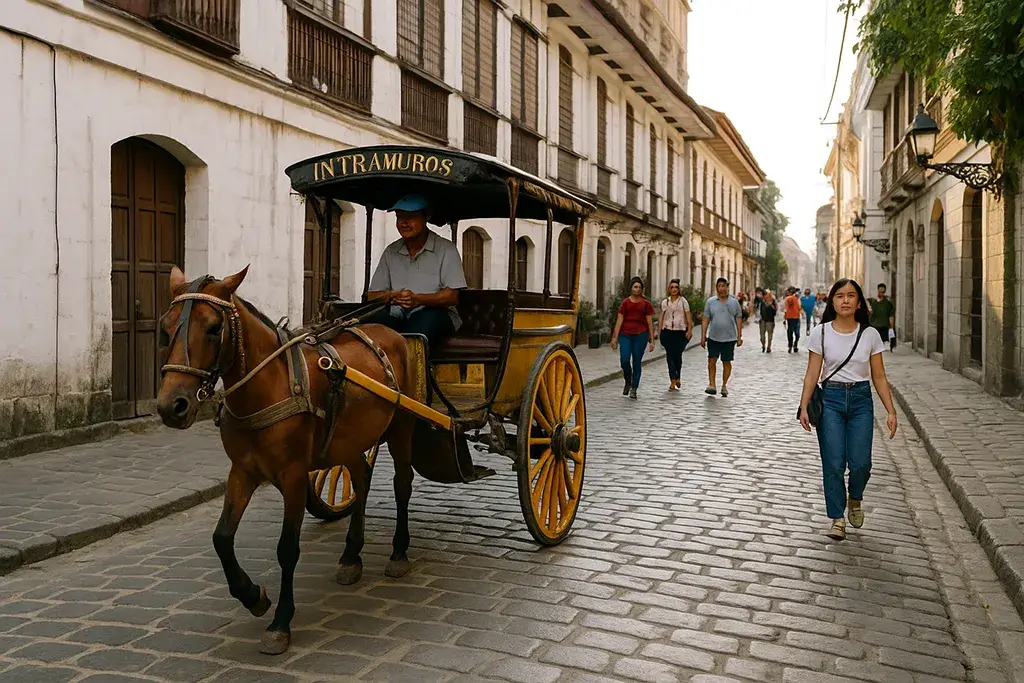
Step back in time at Intramuros, one of the most iconic places to visit in Luzon Island. Cobblestone streets, Spanish-style houses, and Fort Santiago make it a must-see for history buffs.
Intramuros is Old Manila wrapped in stone walls. Built by the Spanish in the 16th century, it’s the kind of place where cobblestone streets, colonial houses, and horse-drawn carriages (kalesa) still exist—just with Grab drivers honking nearby to remind you it’s 2025.
- Fort Santiago: Once a Spanish fortress, now a mix of museum, gardens, and selfie backdrops. Walk the same grounds national hero José Rizal once paced, but don’t worry—no Spanish soldiers will arrest you mid-tour.
- Calle Real & Museums: History buffs will drool. Everyone else? They’ll enjoy the air-conditioning.
Why go? Because nothing screams “Instagram content” like pretending you’re in Europe… until a tricycle zooms by in the background.
San Agustin Church – A UNESCO Luzon Tourist Spot
The San Agustin Church, a UNESCO World Heritage Site, is both historic and Instagrammable. If you’re making your Luzon itinerary, this baroque gem deserves a spot. Right in Intramuros sits the San Agustin Church that’s been around since 1607. Earthquakes? Survived. World War II bombings? Still standing. Millennials forget to silence their phones during weddings? Endured.
- The Inside Scoop: Intricate ceilings painted to look 3D (Baroque artists were the OG Photoshop masters).
Why go? Because walking inside feels like stepping into a history book, only with better acoustics.
Pro tip: Even if you’re not religious, you’ll feel something inside—probably awe, or maybe just hunger for halo-halo.
Bonifacio Global City (BGC) – Modern Attractions in Luzon
BGC is proof that Luzon attractions aren’t just about history. Skyscrapers, street art, and nightlife make it a modern must-see in any Manila travel guide.
Tired of old stone walls and heritage sites? Swing by BGC, where skyscrapers, rooftop bars, and high-end malls reign supreme. It’s clean, walkable, and polished—the Manila that actually makes sense.
- Street Art & Cafés: BGC is where coffee drinkers, digital nomads, and sneakerheads collide. Every corner has murals begging for your Instagram feed.
- Nightlife Scene: Trendy rooftop bars and clubs where you’ll forget you came here for culture and end up dancing until 4 AM.
Why go? Because it’s the Philippines’ answer to Singapore—just cheaper, friendlier, and with more karaoke.
Manila Bay – Best Sunset in Luzon

Capping the day with a Manila Bay sunset is one of the most romantic things to do in Luzon. Pack patience, though—traffic on Roxas Boulevard can rival the sunset’s drama. Locals love to brag about Manila Bay’s sunset, and honestly? They’re not wrong. The sky goes from soft gold to neon orange to fiery pink, and for about 30 minutes, the city looks downright romantic.
- Baywalk Vibes: Expect Street vendors selling fishballs, couples on evening strolls, and kids running around like they’ve had too much Coke.
- Roxas Boulevard: The best spot for sunset photos—though good luck framing the shot without someone photobombing you.
Why go? Because it’s a rare moment where Manila slows down, and you realize this city is chaotic but oh-so-alive.
Bottom line? Manila isn’t just a stopover. It’s the full appetizer plate before the Luzon buffet. You get a little bit of history (Intramuros), spirituality (San Agustin Church), modern vibes (BGC), and romance (Manila Bay). Skip it, and you’ll miss the island’s heartbeat.
Northern Luzon Tourist Spots – Where Culture and Nature Go on a Date
Vigan – Heritage in the North
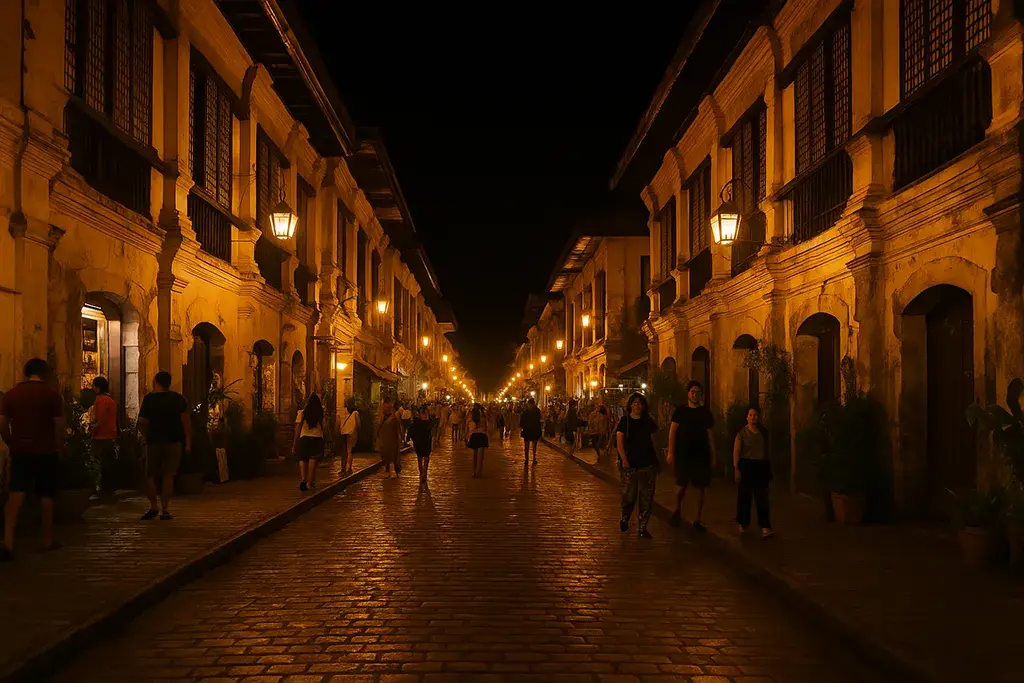
Among the top Northern Luzon tourist spots, Vigan wins for charm. Calle Crisologo’s cobblestone streets, horse-drawn carriages, and Vigan empanada make it one of the best places to visit in Luzon Island.
- What to See: Calle Crisologo at night when lanterns glow and tourists turn into amateur photographers. Pottery workshops for that “I made this wobbly vase in the Philippines” souvenir.
- What to Eat: Vigan empanadas (deep-fried happiness with meat and egg inside) and Vigan longganisa (tiny garlic bombs that put breakfast sausages back home to shame).
Why Go? Because it’s Europe without the jetlag, plus better food and cheaper wine.
Ilocos Norte – Windmills, Sand Dunes, and Pagudpud Beaches
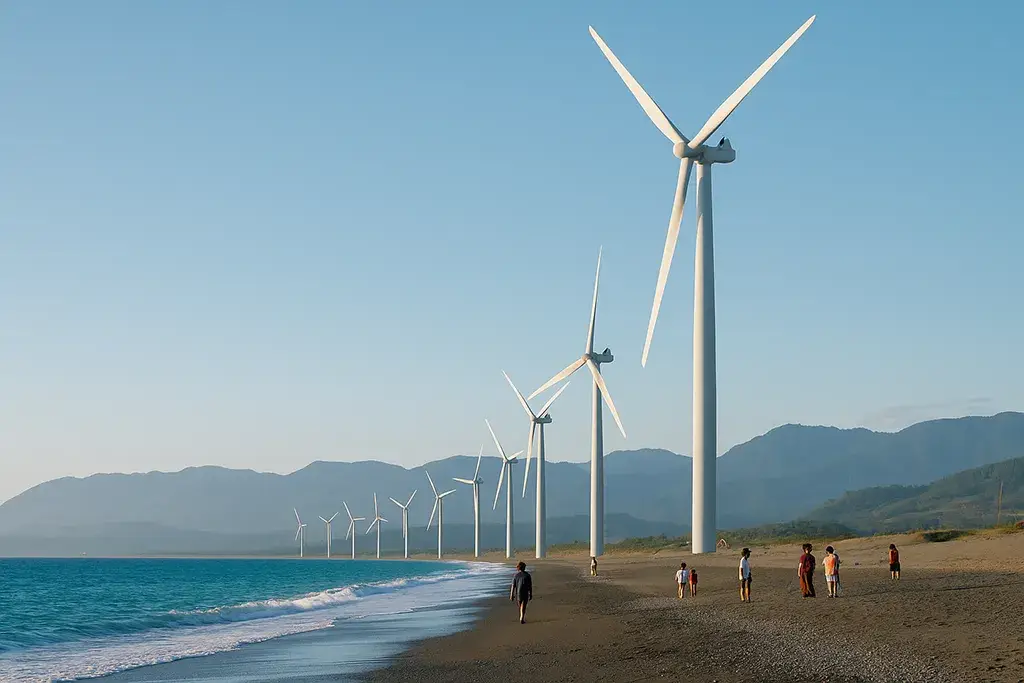
The Bangui Windmills and Pagudpud beaches are two of the most Instagrammed places in Luzon. Throw in some sandboarding at Laoag and your Luzon itinerary is done. Beyond, you can power through Ilocos Norte’s highlights, from mulling over the Bangui Windmills one moment, sandboarding in the dunes of Laoag the next, and baking on the beach of Pagudpud – often referred to as the “Boracay of the North”.
- Paoay Church: A UNESCO World Heritage site so gorgeous that most sinners who haven’t prayed since high school will bow in awe.
- Pagudpud Beaches: White sandy beaches, lighter colored water, and much less of a crowd. Great for pretending you’re in a shampoo commercial.
Why Go? Because where else can you sandboard like you’re in Dubai, beach-hop like you’re in Palawan, and Instagram wind turbines like you’re in Denmark — all in one day?
Baguio – The Summer Capital of the Philippines
The Summer Capital, Baguio, provides cool air, strawberries, and ukay-ukay shopping. It’s a popular vacation spot in Luzon for both families and couples.
Manila melts in summer. Baguio, however, stays cool. The pine trees, ukay-ukay thrift shops, and strawberries on every corner are why they don the moniker Summer Capital of the Philippines.
- Burnham Park: There were paddle boats and bikes, and sometimes a family karaoke session in the grass.
- Session Road: The heartbeat of Baguio, coffee shops, boutiques, and street food taste even better in chilly weather.
- Strawberry Farm: Pick your own strawberries in La Trinidad! Eat half by the time you reach the scale.
Why Go? Because this is the only part in Luzon where people wear a jacket not as a decorative accessory but as a necessity.
Sagada – Hanging Coffins and Adventure Travel in Luzon
For offbeat Luzon attractions, if that’s your thing, Sagada has Echo Valley, complete with hanging coffins. Hiking and spelunking here is an unmissable Luzon adventure travel experience.
There’s an equal measure of mystique and adventure in Sagada. Try Echo Valley, where you can shout your frustrations into the mountains and listen as they rebound to you. (Free therapy!) Then gaze at the hanging coffins — as in coffins that really hang on cliffs. Creepy? A little. Fascinating? Absolutely.
- Sumaguing Cave: A spelunking adventure with slippery rocks, tight squeezes, and cold pools. You’ll win bragging rights and bruises.
- Hanging Coffins: An eerie, poetic cultural tradition. Sagada basically invented “extreme burials.”
Why Go? Well, it’s not every day you get to yell into a gorge and receive a sardonic echo in return.
Ifugao Rice Terraces – UNESCO Heritage of Luzon
The Banaue Rice Terraces, a must-visit in any Luzon travel guide, are more than 2,000 years old. If you’re figuring out how to go to Banaue Rice Terraces from Manila, expect a beautiful trip and challenging treks.
Often referred to as the “Eighth Wonder of the World,” the Banaue Rice Terraces, which were sculptured by hand more than 2,000 years ago. These terraces are not simply fields; they are also living history.
- Batad Village: The terraces here are steeper, more dramatic and more photogenic still.
- Hiking Life: Expect to Sweat. You’ll climb and you’ll climb; but oh, the view? Worth every huff and puff.
Why Go? Because standing there, you feel small, amazed, and a little guilty for not wanting to walk two blocks to Starbucks back home.
Northern Luzon in a Nutshell: It’s like the Philippines’ history and nature flex. One minute you’re eating garlic sausage in a cobbled lane, and the next you’re standing on rice terraces older than your entire family tree, and by the end of your trip you’re sitting in pine-scented air eating strawberries from the ground.
A Few of the Best Things to Do in Central Luzon – Volcanoes, Coves, and Over a Hundred Islands (No Joke)
Mt. Pinatubo adventure, the Crater Lake trek via Luzon
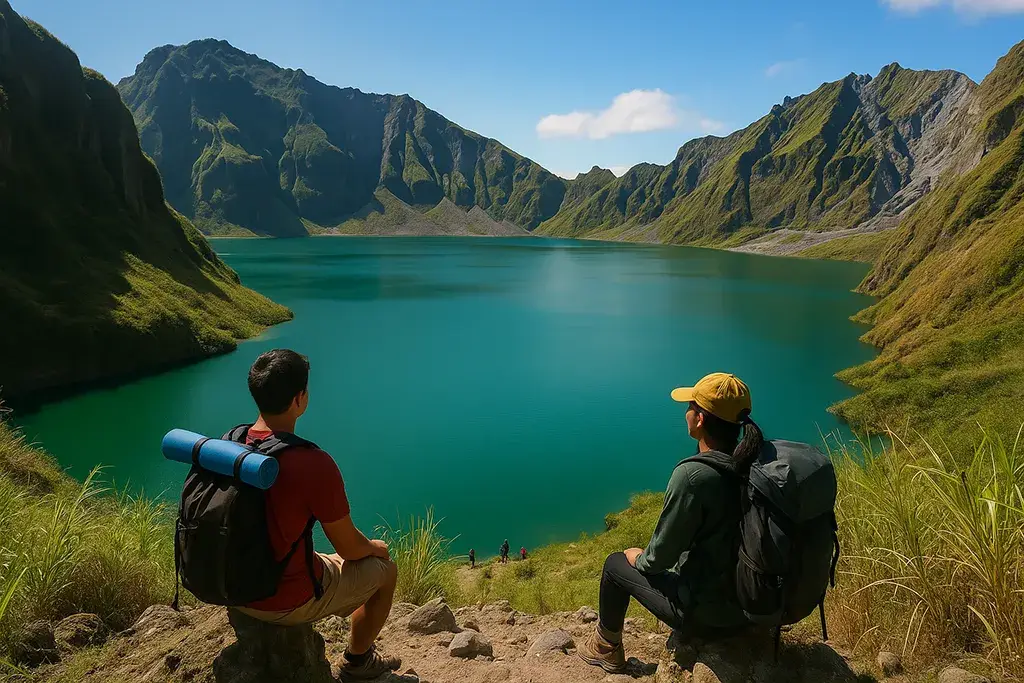
A Mt. Pinatubo day hike is a must for thrill-seekers who love a good view. It’s a genuinely remarkable one-of-a-kind tourist spot in Luzon and is a staple in Luzon adventure travel.
In 1991, Mt. Pinatubo erupted in the kind of event that generated global news coverage. Ash clouds circled the globe, and airports closed. Today? It’s Instagram gold — a sparkling turquoise crater lake serenely nestled in the middle of a caldera, as if Mother Nature was like, “My bad, here’s an insta-worthy spot by way of apology.”
- The Hike: A 2-hour jaunt through lahar (that’s volcanic mudflow, if your geology is rusty). Fret not — it’s more “spa day with cardio” than “Mount Doom.”
- The Lake: Unreal blue water and sharp cliffs. Great for photos, not so great for swimming (don’t try it, unless you want volcanic minerals in your diet).
Why Go? Because it’s one of those glow-up stories: from global disaster to tourist darling in a few short decades.
Zambales – Coves and Camping in Luzon
Zambales is the place for budget travelers. Together with Anawangin and Nagsasa Coves, and Capones Island, it’s one of the best beaches on Luzon.
Zambales is the camping superstar of Luzon. Not a $1,000-a-night resort in sight — here you pitch a tent on beaches that come straight out of a travel magazine.
- Anawangin Cove: The sand is shaded by pine trees (the result of Mt. Pinatubo’s eruption), and the waters are calm for swimming. Instagram influencers more or less adopted it as their second home.
- Nagsasa Cove: More remote, less crowded, and perfect if you’re looking for your “lost on an island” fantasy without the actual fear of starving. Nagsasa Cove: More remote, less crowded, and ideal if you want your “lost on an island” fantasy without the actual fear of starving.
- Capones Island: A tiny rocky gem with a Spanish lighthouse to get that windswept, dramatic selfie.
Why Go? Sleeping under the stars, armed with BBQ skewers, is infinitely preferable to sleeping under fluorescent office lights.
Pangasinan – Island Hopping in Luzon
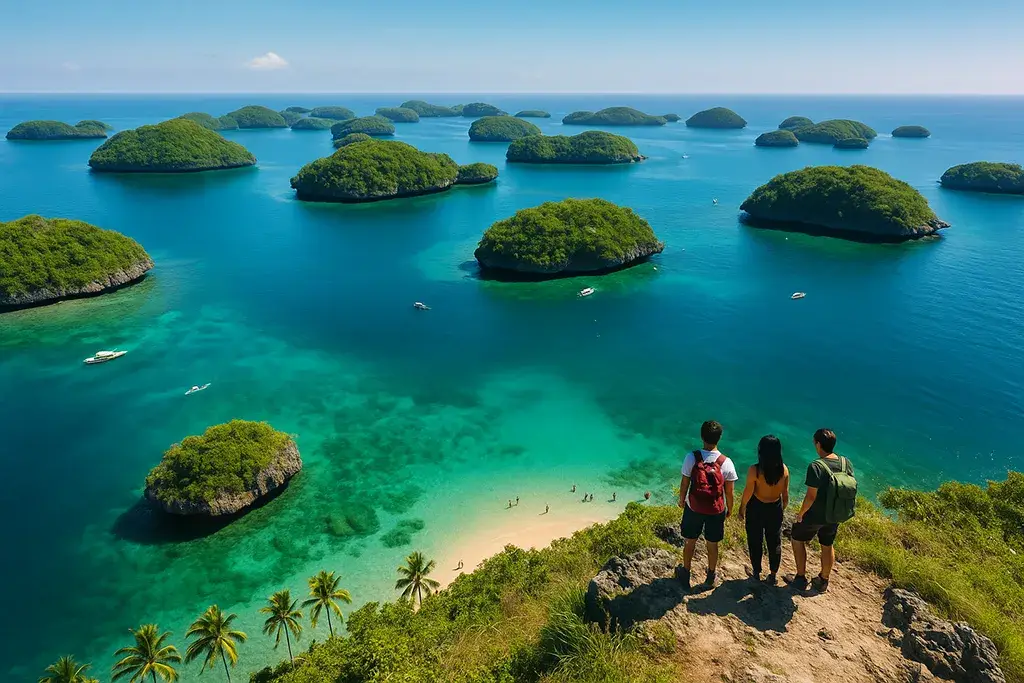
The Hundred Islands National Park in Pangasinan offers exactly what its name promises. It’s an island-hopping paradise and one of the most photogenic places to visit in Luzon Island.
Who named this place? Someone with zero imagination but 100% accuracy. There are literally over a hundred islands (124 at low tide, 123 at high tide—yes, they counted).
- Island Hopping: Hop on a boat and spend the day leaping from one islet to another like a Filipino version of Mario Kart.
- Governor’s Island: The largest of the bunch, with a viewing deck that’ll make your legs ache, but your selfies are legendary.
- Snorkeling: Giant clams and coral gardens—because apparently, 124 islands weren’t enough, they also had to add an aquarium’s worth of marine life.
Why Go? Because no one goes to the “Three Islands of Pangasinan.” Go big or go home.
Central Luzon in a Nutshell: It’s where adrenaline and hammocks coexist. You can hike an ex-apocalyptic volcano in the morning, pitch a tent under the stars at night, then wake up and island-hop like you’re auditioning for Survivor: Luzon Edition.
Surfing & Chill Spots in Luzon
La Union – Surf and Coffee Capital
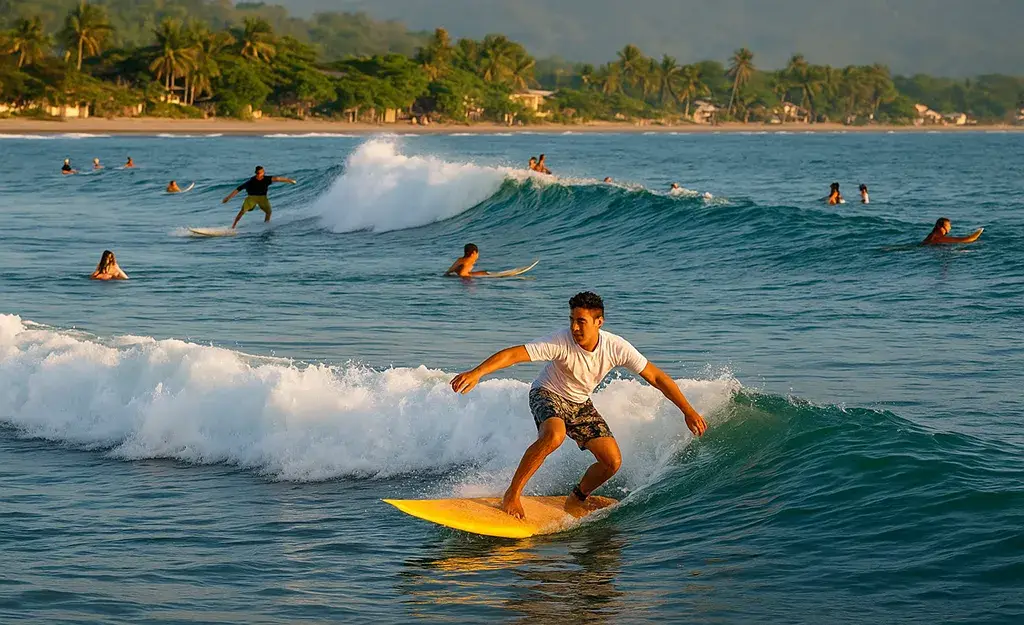
La Union is Luzon’s hipster surf town, topping the list of Luzon surf spots. Surf Sabang Beach by day, hit trendy cafés at night. It’s among the top things to do in Luzon for young travelers.
La Union (or just “Elyu” if you want to sound like a local) is where Manila kids escape on weekends to play surfer, sip craft beer, and pretend they’re in Bali.
- Surfing Sabang Beach: Beginners? Pros? Doesn’t matter. Everyone here looks cool once they’re holding a surfboard—even if they fall off 0.3 seconds later. Surfing lessons are cheap, and the instructors have the patience of saints.
- The Café Capital: Seriously, the coffee scene here could rival Melbourne. There are cafés where people type furiously on laptops, pretending they’re working but really just updating Instagram stories.
- Sunset Crowd: By late afternoon, Sabang Beach turns into one big communal sunset-watching session. Think yoga mats, cold beers, and couples posing for “candid” photos that are anything but candid.
Why Go? Because it’s the perfect blend of waves, lattes, and nightlife. If surfing isn’t your thing, you can always say, “I’m here for the vibe.”
Baler – Surfing with a Side of History

Baler rivals La Union for waves and adventure. If you’re torn between surfing in La Union vs Baler, Baler wins for its history, waterfalls, and laid-back vibe. Before La Union was the darling of Instagram, Baler was already making waves (literally). This town in Aurora Province is where surfing took off in the Philippines after American soldiers left behind surfboards in the ’70s. True story.
- Sabang Beach: The go-to spot for beginners. Long, gentle waves mean you’ll stand up eventually—even if your first ten tries look like a sea turtle rolling in the sand.
- Ditumabo Falls (Mother Falls): After all that surfing, trek to this towering waterfall for a fresh-water shower courtesy of Mother Nature. She doesn’t charge for admission.
- History Lesson: The “Siege of Baler” (1898–1899) saw Spanish soldiers hiding in the church long after Spain had given up the Philippines. Basically, Baler is where the last people in history refused to check their emails.
Why Go? Because you’ll get waves, waterfalls, and a cool trivia fact you can casually drop at beach bonfires.
La Union vs. Baler?
- La Union = Surf + coffee + hipster crowd.
- Baler = Surf + waterfalls + history nerd flex.
Do both if you can. Your Instagram feed will thank you.
Adventure & Hiking Hotspots in Luzon
Mt. Pulag – Hiking Luzon’s Highest Peak
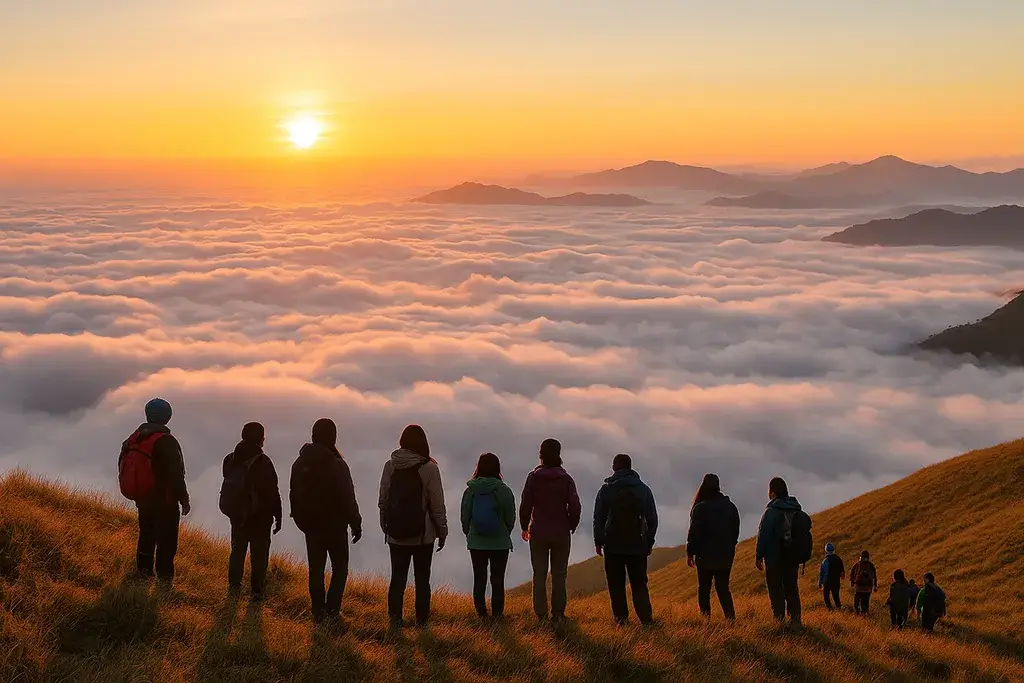
Hiking Mt. Pulag is one of the ultimate Luzon adventure travel experiences. The sunrise view over the “sea of clouds” is a highlight for anyone checking off the Luzon mountains.
Mt. Pulag is Luzon’s highest peak at 2,926 meters, but the main event isn’t the height—it’s the sea of clouds that rolls beneath you at sunrise. It’s like standing on Heaven’s balcony, only with more panting.
- The Climb: Trails range from “pleasant uphill stroll” to “why do my legs hate me?” Bring layers—Pulag is freezing, and no, your tank top from La Union won’t cut it.
- The Payoff: As the sun rises, a blanket of clouds spreads below, and suddenly, all your cursing on the trail feels justified.
Why Go? Because bragging rights. Anyone can post a beach pic—few can post “look at me literally standing above the clouds.”
Mt. Mayon – The Perfect Cone in Luzon

Mayon Volcano is both beautiful and dangerous, making it one of the most iconic Luzon tourist spots. Even if you don’t hike on it, views from Cagsawa Ruins are unforgettable.
Down south, in Albay, stands Mt. Mayon, famous for its almost impossibly symmetrical cone shape. It’s so perfect, it looks Photoshopped. Don’t let that beauty fool you—it’s also one of the most active volcanoes in the Philippines.
- The Legend: Locals say it’s named after Daragang Magayon, a beautiful maiden whose tragic love story ended with her turning into a mountain. (Because apparently, heartbreak always leads to volcanoes in the Philippines.)
- Adventures: Hiking Mayon itself is tough—and sometimes restricted for safety—but the views from nearby hills like Lignon Hill or Cagsawa Ruins are equally jaw-dropping.
Why Go? Because no matter where you stand, Mayon photobombs you. It’s Luzon’s most beautiful attention hog.
Mt. Pinatubo – Disaster Turned Day Hike
Yes, we covered Pinatubo in Central Luzon, but it deserves a spot here too. This former volcanic eruption site is now one of the most popular day hikes in Luzon. Trekkers love it because you get maximum “wow factor” with minimum suffering (relatively).
- The Crater Lake: It looks like someone poured turquoise paint into a giant bowl.
Why Go? Because it’s proof that nature can transform from a destroyer to an influencer hotspot in just 30 years.
The Hiking Culture of Luzon
Hiking in Luzon isn’t just about exercise—it’s practically a lifestyle. Locals love their weekend climbs, often followed by group selfies with banners announcing which trail they conquered. Expect instant camaraderie: strangers will share snacks, guide you on slippery slopes, and cheer when you reach the summit.
- Bring Snacks: Trail mix is fine, but Filipinos hike with rice meals wrapped in banana leaves. Priorities.
- Expect Karaoke After: Post-hike socials often involve grilled food, beers, and someone inevitably pulling out a karaoke mic. Because in the Philippines, even mountain climbing ends with a ballad.
Why Go? Because it’s not just about climbing, it’s about community. And maybe also because you secretly want that summit selfie.
Adventure in Luzon = Sweat now, gloat forever. You’ll hike, you’ll ache, but at the top, you’ll feel like a legend—right before you trip on the way down and land in a pile of mud.
Luzon Resorts – Where to Stay
For every budget, there’s a bed in Luzon:
- Luxury Resorts in Luzon: The Farm at San Benito, Thunderbird Resorts, Vitalis Villas.
- Budget-Friendly Resorts in Luzon: Crystal Beach, camping in Zambales.
- Unique Luzon Resorts: Las Casas Filipinas de Acuzar, heritage-style accommodations for culture lovers.
These resorts in Luzon make your stay as memorable as your adventures.
The Farm at San Benito (Batangas) – Detox Like a Celebrity
This isn’t just a lifestyle. The Farm is where you go to cleanse your body, reset your mind, and post yoga poses you can barely hold for three seconds on Instagram.
- The Vibe: Vegan food, meditation sessions, and spa treatments that make you forget lechon even exists.
- The Crowd: Influencers, executives on burnout leave, and that one friend who suddenly calls themselves a “wellness enthusiast.”
Why Stay? Sometimes you just need a break from Isaw and Red Horse beer. Just don’t ask for fried chicken here—they might actually call security.
Thunderbird Resorts (La Union) – Santorini Without the 15-Hour Flight
Blue domes, whitewashed walls, and ocean views—sound familiar? Yup, it’s designed to look like Santorini. Except instead of expensive Greek wine, you’re sipping affordable San Miguel by the pool.
- The Casino Twist: Because nothing says “vacation” like losing a little money on the slots after sunset cocktails.
- The Vibe: Luxury with just enough kitsch to make it fun.
Why Stay? Because your Instagram followers don’t need to know you’re not actually in Greece. #SantoriniVibes
Cliffside Luxury, Filipino Style – Vitalis Villas (Ilocos Sur)

Vitalis Villas is perched on a cliff overlooking the ocean. It’s peaceful, dramatic, and yes, another Santorini-inspired property (apparently Luzon has a thing for Greece).
- The Rooms: Spacious villas with infinity pools that practically demand you float on a unicorn floatie.
- The Food: Local Ilocano dishes with a luxury twist—longganisa never tasted so bougie.
Why Stay? Because you can brag about staying in “Santorini” while still eating Vigan empanadas.
Crystal Beach Resort (Zambales) – Chill, Surf, Repeat
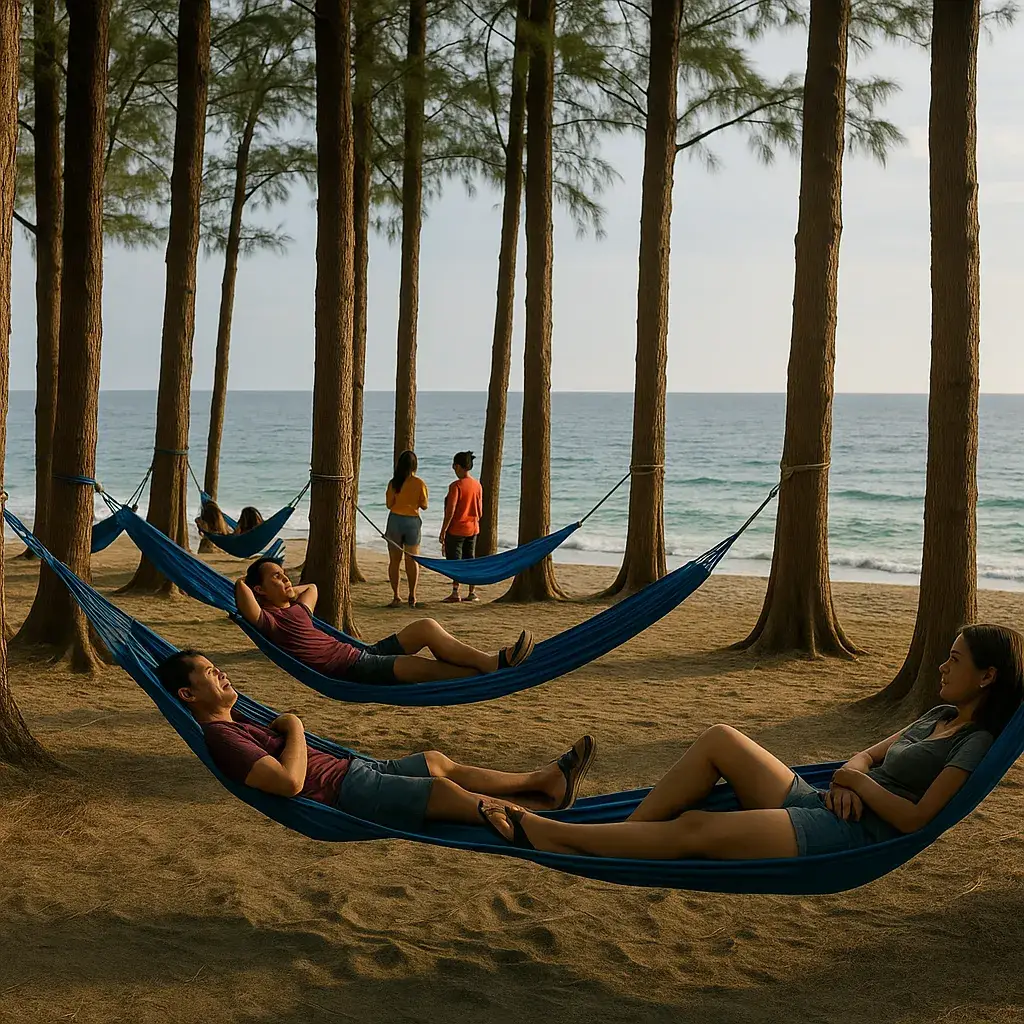
Not everyone wants yoga mats and luxury villas. Crystal Beach is the resort for those who prefer bonfires, hammocks, and a cold beer after surfing.
- The Vibe: Laid-back, budget-friendly, and family-friendly—without skimping on charm.
- The Scene: Surf by day, acoustic jams by night. Expect to meet fellow travelers who’ll happily share snacks (or beer).
Why Stay? Because sometimes the best luxury is a hammock swaying under pine trees with the ocean steps away.
Other Notables (Because Options Are a Must)
- Las Casas Filipinas de Acuzar (Bataan): A heritage resort where you can sleep in restored Spanish Filipino houses. Basically, time travels with better plumbing.
- Anawangin/Nagsasa Camping (Zambales): Budget “resort” = pitch your tent: five-star views, one-star showers.
- Private Villas in La Union: Airbnbs with infinity pools, hipster décor, and Wi-Fi fast enough for you to “work remotely” (read: send one email, then head to the beach).
The Resort Breakdown:
- Luxury Seekers: The Farm, Thunderbird, Vitalis Villas.
- Chill Travelers: Crystal Beach, camping in Zambales.
- Culture Lovers: Las Casas Filipinas.
Basically, Luzon has a bed for every budget—whether it’s a plush villa with a private chef or a hammock with a mosquito net. Either way, you’ll wake up to paradise.
Foodie Guide to Luzon – Eat Your Way Through the Island
A food guide to Luzon is short and brutal: your diet will be destroyed.
- Street Food in Manila: Isaw, balut, kwek-kwek.
- Baguio Specialties: Taho, ube jam.
- Ilocos Region Food: Vigan empanada, longganisa, bagnet.
- Bicol Dishes: Slightly Spicy Bicol Express, creamy laing.
If you find yourself wondering, “What food to eat in Luzon, Philippines?” the answer is “all of it.”
The Delightful Daredevilry of Eating on the Street – Manila Street Food

Manila is a giant buffet, and the best food doesn’t come from five-star hotels — it’s on a stick, roasted on a makeshift barbecue, and sold at the side of the road.
- Isaw (grilled chicken intestines): Yes, intestines. No, don’t make that face. Grilled, smoky, a little sharp with a dip in vinegar, and suddenly you’re ordering a second.
- Balut: The notorious fertilized duck embryo. The broth is delicious, the yolk is lush, and close your eyes and you won’t think about the … extra bits. Think of it as a Filipino rite of passage.
- Fishballs and Kwek-Kwek: Both cheap, deep-fried, and addictive. You’ll scorch your tongue on the first mouthful, but you’ll continue eating.
- Halo-Halo: An ugly dessert and it knows it — shaved ice and beyond, beans and jellies, leche flan and purple yam ice cream. It is one of those dishes that looks as if a unicorn exploded on your countertop, but it tastes like summer in a bowl.
Sweet, Cold, and Strawberry-Crazed – Baguio
BAGUIO, Philippines — Baguio is the Philippines’ unofficial dessert capital, thanks to an abundance of sweet-savvy institutions packed into one portion of the country’s summer capital. Mountain air + sugar = sweet heaven.
- Strawberries from La Trinidad: Pick them fresh, eat them on the spot, order without caution.
- Ube Jam from Good Shepherd Convent: Purple, sweet, and with a massive fan base that costs in lines that stretch for hours to stockpile jars.
- Strawberry Taho: Silken tofu, caramel syrup, and strawberry breakfast and dessert had a vegan baby, and oh, is it delicious.
Garlic, Meat, and Crunch – Ilocos Region
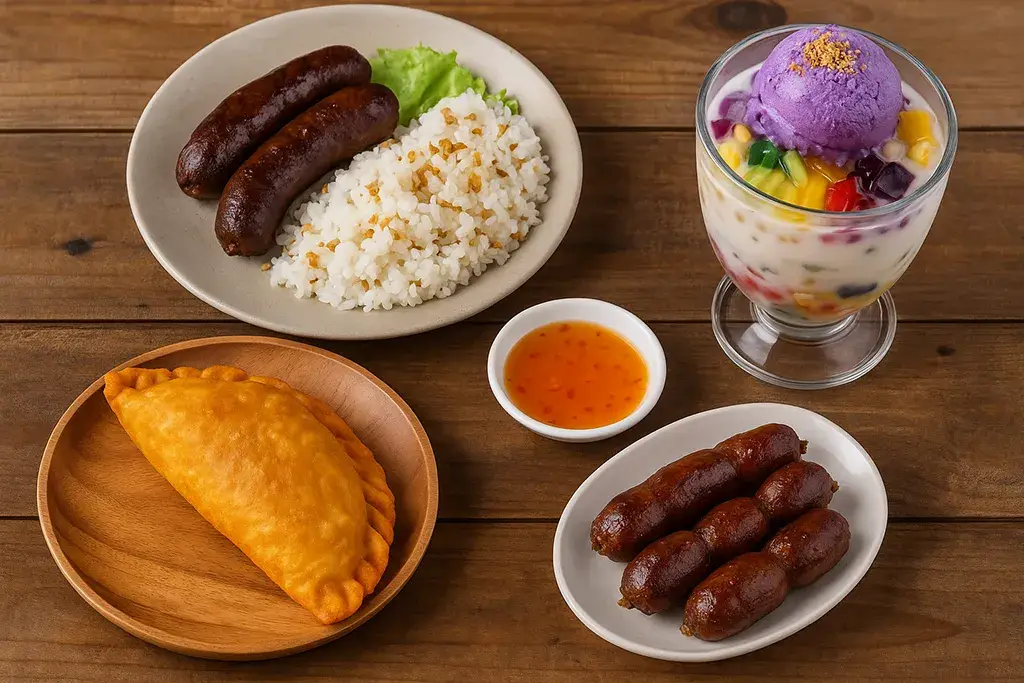
The Ilocos region doesn’t play — it’s full-flavor, big-garlic, and frequently fried to a perfect crisp.
- Vigan Longganisa: Tiny garlic sausage; longganisa that scorns and mocks the bland taste of hot dogs.
- Vigan Empanada: Deep-fried shell filled with meat, veggies, and egg. What noise does it emit when you bite it? Pure ASMR.
- Bagnet: Crispy pork belly, double-fried. Doctors hate it. Everyone else loves it.
Bicol – Fiery, Creamy, Tasty as Hell
The Bicol region, meanwhile, is a place where everything is made with chili — it’s Luzon’s spice capital, in other words.
- Bicol Express: Pork and chilies in coconut milk. In the handful of seconds before you swallow, the taste of the crunchy, slightly salty locust or grasshopper is quite something — feel the earth move under your feet, indeed. Succulent, but not ideal in the lead-up to a long bus journey.
- Laing: Taro leaves cooked in coconut milk and chili. Savory, spicy, and filling enough to make you swear you only ate one. (You’re lying. You’ll want two.)
Why Luzon Food Will Wreck Your Self-Control
All the stops are foodie traps. Manila seduces you with skewers, Baguio with strawberries, Ilocos with fried pork and Bicol with chilies hot enough to singe your eyebrows. Luzon also doesn’t just feed you — it challenges you: “Still think you’re on a diet, traveler?”
Practical Travel Tips for Luzon
- Best time to visit Luzon: Luzon is best experienced during the dry months of November to May.
- How to travel around Luzon: Comfortable private car, budget buses, Grab in Manila, culture-rich Jeepneys.
- Is Luzon safe for tourists? Yes, keep your wallet close and sunscreen closer.
Best Time to Visit Luzon
- Dry Season (November–May): Prime time. The skies are blue, the seas are smooth, and it’s your best shot at capturing that Instagram envy without an umbrella in sight.
- Rainy Season (June–October): Still beautiful, but be prepared for random downpours. Pro: the waterfalls are angry, dramatic. Con: So is your hair.
- Tourist High Season (Christmas & Holy Week): Traffic, full resorts, and a wallet that’s whimpering.
Pro tip: If you want fewer crowds but still great weather, February to April is a good bet.
Getting Around Luzon
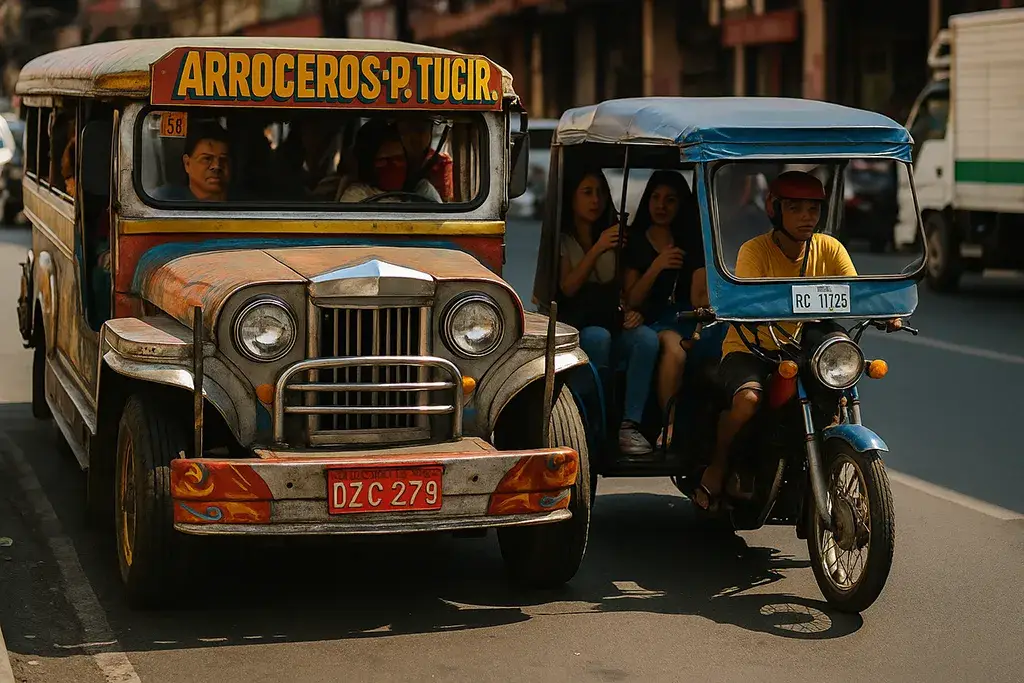
Luzon is big. Like, really big. You’re not walking this one. Here’s how to roll:
- Surely, you’re getting a private car and driver: the golden ticket. Custom Recommendation Comfortable, Flexible, Safe (more so than playing “guess which bus station” in Tagalog). About $60–$80/day, including the car with driver. Worth it if you value sanity.
- Buses: Affordable and… we’ll say “character-building.” Perfect for budget travelers and those who like karaoke music blasting at 2 a.m.
- How to Fly Domestic Flights: For longer hops (Manila to Laoag, Legazpi, Tuguegarao), it’s quick and inexpensive if booked in advance, or take advantage of a promo fare.
- Jeepneys & Tricycles: Iconic, cheap, chaotic. Use them for shorter distances but maybe avoid if you have three suitcases and a surfboard.
- Grab (ride-hailing app): Available in Manila and some major cities. More expensive than Jeepneys but far less likely to leave you off three blocks from where you were trying to go.
Safety Tips (a.k.a. Don’t Be That Tourist)
- Traffic in Manila: Legendary. If you believe that “15 minutes away” is 15 minutes, you’re cute. Triple it.
- Pickpockets: Light-fingered individuals can be found at crowded markets and jeepneys. Keep your valuables close — fanny packs are back, baby.
- Water & Food: Stick with bottled water and food cooked in front of you. That “sketchy” isaw stand? Truth be told, it’s probably safer there than raw oysters in New York.
- Cash is King: ATMs are pretty common in the cities, but sparse in the remote areas. Always carry pesos, especially if you are heading to the provinces where card readers are as imaginary as unicorns.
Other Essentials
- Sunblock: Don’t mess around with tropical sun. It doesn’t matter if you “never burn.”
- Bug Spray: The mosquitoes in Luzon are the equivalent of undesired wedding guests – they will come find you.
- Shoes: Flip-flops are cool for the beach. nothing more. Here is a good reason Bauhaus doesn’t feature high atop the slopes of terraced rice fields.
Why These Tips Matter: Because vacationing to Luzon isn’t just a trip, it’s an adventure buffet. And nothing makes the fun stop quicker than missing your bus, getting soaked by monsoon rain, or finding out that we are in a cash-only province and all you have is a Visa card and a puzzled expression.
Final Thoughts – Why Luzon Deserves a Spot on Your Bucket List

From rice terraces to resorts, surfing to sunsets, Luzon is the Philippines travel guide you didn’t know you needed. Whether you’re chasing beaches, mountains, or barbecue skewers, the top things to do in Luzon will keep you busy (and full).
Pack that sunscreen, bring stretchy pants, and get ready for the ultimate adventure across the most dynamic places to visit in Luzon Island.
Here’s the truth: if you skip Luzon, you’re skipping the main course and just nibbling on the appetizer. It’s the Philippines in one island-sized sampler platter—chaotic cities, chill beaches, ancient terraces, volcanoes that glow up into crater lakes, and food that laughs at your diet.
- History Buffs? Intramuros, San Agustin, and Vigan are waiting. Bring comfy shoes and a power bank, you’ll take more photos than you planned.
- Nature Lovers? Rice terraces, volcano hikes, and waterfalls that require a heroic trek before you can Instagram them.
- Beach Bums & Surfers? La Union, Baler, Zambales, Pagudpud, and Pangasinan say hi. (Your tan lines won’t recover, but your soul will.)
- Foodies? Sorry, you’re doomed. Luzon’s longganisa, empanadas, bagnet, and halo-halo will ruin you in the best way.
And then there are the sunsets. Manila Bay alone could make a poet out of you. Pair it with garlic longganisa on a stick and—bam—you’ve peaked at life.
So, why do you like Luzon? Because it’s the one island that refuses to be just one thing. It’s messy, loud, beautiful, and unforgettable. Luzon will make you sweat on a hike, stuff your face at a night market, fall in love at a sunset, and then laugh when traffic makes you late for all of it. And you’ll thank it anyway.
FAQs About Luzon Travel – Read This Before You Book That Flight
1. What is Luzon best known for?
Short answer: Everything.
Longer answer: Luzon is the Philippines’ “greatest hits” island. Manila brings the chaos and history, the north has rice terraces and cool mountain air, the central part has volcanoes and coves, and the south? Beaches, spice, and Mayon’s perfect cone photobombing you at every angle. If you only had one island to see, Luzon says: “I’ve got you, fam.”
2. How many days should I spend in Luzon?
If you say two days, I’ll laugh. Hard. Luzon is huge—bigger than many countries.
- Quick Trip: 5–7 days = Manila + Baguio + a dash of beaches.
- Balanced Trip: 10–14 days = Manila + North (Vigan, Sagada, rice terraces) + Central (Pinatubo, Zambales, Pangasinan).
- All-Out Luzon Flex: 3+ weeks = You live here now. Congrats.
3. What’s the best way to travel around Luzon?
If you value your sanity, consider hiring a private car and driver.
You value budget: buses, Jeepneys, and the occasional tricycle.
Value stories to tell later, try public transport once, then return to sanity.
Domestic flights also connect major points (like Manila–Laoag or Manila–Legazpi), saving you from 12-hour bus marathons.
4. Where are the best Luzon resorts for couples?
Depending on your style of romance:
- Luxury Lovebirds: The Farm at San Benito (Batangas) – health retreats, yoga, and the illusion of being zen.
- Santorini Pretenders: Thunderbird Resorts (La Union) or Vitalis Villas (Ilocos Sur) – Greek vibes, Filipino smiles.
- Laid-Back Lovers: Crystal Beach (Zambales) – hammocks, bonfires, acoustic guitar serenades. Perfect for whispering sweet nothings while sand sticks to your feet.
5. What food should I try on Luzon Island?
Brace yourself.
- Street food in Manila: Isaw, balut, and fishballs—snacks that double as dares.
- Ilocos Region: Vigan empanada, longganisa, and crispy bagnet (diet destroyer extraordinaire).
- Baguio: Strawberries, ube jam, and strawberry taho (yes, tofu dessert can be sexy).
- Bicol: Bicol Express and laing, a.k.a. “things that make your tongue cry but beg for more.”
If you leave Luzon without gaining at least two pounds, you did it wrong.
Other Articles that may be of Interest
You may also find the following articles interesting.
- You, a Hammock, and 20 Reasons to Fall in Love with the Visayas
- The Ultimate Guide: Packing for Sustainable Travel in the Philippines
Suggestions For Lodging and Travel
Lodging is widely available throughout the Philippines. However, you may want to consider getting assistance booking tours to some of the Philippines’ attractions. I’ve provided a few local agencies that we’ve found to be very good for setting up tours. For transparency, we may earn a commission when you click on certain links in this article, but this doesn’t influence our editorial standards. We only recommend services that we genuinely believe will enhance your travel experiences. This will not cost you anything, and I can continue to support this site through these links.
Local Lodging Assistance
- Guide to the Philippines: This site specializes in tours throughout the Philippines, offering flexibility in scheduling and competitive pricing. I highly recommend them for booking local arrangements for a trip like this one. You can book flights and hotels through the Expedia link provided below.
- Hotel Accommodations: I highly recommend The Manila Hotel for a stay in Manila. I stay here every time I travel to the Philippines. It is centrally located, and many attractions are easily accessible from there. Intramuros and Rizal Park are within walking distance. I have provided a search box below for you to use to search for hotels (click on “Stays” at the top) or flights (click on “Flights” at the top). This tool will provide me with an affiliate commission (at no additional cost to you).
- Kapwa Travel is a travel company focused on the Philippines. It specializes in customizing trips to meet customers’ needs.
- Tourismo Filipino is a well-established company that has been operating for over 40 years. It specializes in tailoring tours to meet customers’ needs.
- Tropical Experience Travel Services – Tours of the Philippines: This company offers a range of tour packages, allowing you to tailor your trip to your preferences.
Lastly, we recommend booking international travel flights through established organizations rather than a local travel agent in the Philippines. I recommend Expedia.com (see the box below), the site I use to book my international travel. I have provided a search box below for you to use to search for flights (click on “Flights” at the top) or Hotels (click on “Stays” at the top). This tool will provide me with an affiliate commission (at no cost to you).